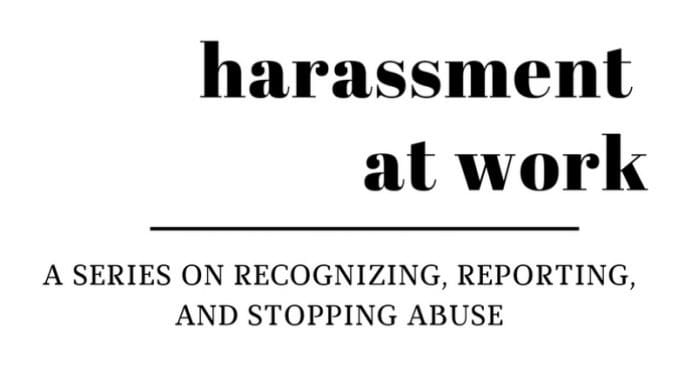
Harassment at work is real, but what do you do when it happens to you? How do you know when someone’s behavior has crossed the line? And who do you tell when it happens to you? In this eight-part series, we break down what harassment is and what to do about it.
BY ASHLEY RODRIGUEZ
BARISTA MAGAZINE ONLINE
Note: This series will explore issues of harassment and recount episodes of alleged harassment in the workplace. If you are sensitive to stories and scenarios depicting workplace harassment, please be advised.
This article is an accompaniment to the February + March 2018 article, “Coexisting at Work: Sexual Harassment Policies,” written by Lauren Lathrop. It’s meant to define sexual harassment and provide a blueprint as to how to handle workplace harassment.
Since October 2017, when a wave of long-hushed sexual harassment stories broke into our collective mainstream, harassment in the workplace has received unprecedented attention. From the #metoo movement started by Tarana Burke to allegations against film director Harvey Weinstein, stories of harassment at the hands of employers, colleagues, and leaders have become commonplace.
Unsurprisingly, the food-and-beverage industry isn’t immune from abuses of power and privilege: Mario Batali stepped down from his restaurant-and-management group, Batali & Bastianich Hospitality Group, after eight women accused him of harassment and misconduct; John Besh of Besh Restaurant Group was accused by 25 women of cultivating a culture that fostered sexual misconduct; and Oakland chef Charlie Hallowell of Pizzaiolo and Boot and Shoe Service stepped away after 17 women recounted alleged incidents of sexual misconduct and verbal abuse. In January, the first legal action taken for harassment in the specialty-coffee sector hit when San Francisco-based Four Barrel cofounder Jeremy Tooker reportedly relinquished his shares after eight women pressed charges against him and the company accusing both of allowing rampant sexual misconduct to go unchecked. The suit has since been settled.
Despite the media coverage these accusations are receiving, many in the hospitality industry are unsure of their rights in the workplace. How do you know if you’ve been harassed? What do you do if you suspect you’ve been a victim of inappropriate behavior? What happens if you witness someone else being harassed? In this eight-part series, we aim to provide answers and clarity, and offer both employees and employers a template for defining, understanding, and stopping harassment in the coffee industry.
PART ONE: Defining harassment.
Fundamental to the discussion of harassment is understanding how harassment is defined. Harassment often gets lumped in as any sort of unfair treatment—broadly speaking, harassment is defined as repeated contact that is not consensual intended to harm, annoy, or alarm. For the purposes of this article, we will speak specifically about workplace harassment, which is defined as a repeated action or behavior targeted towards a protected class of people meant to belittle, embarrass, or discredit them, as defined by the Equal Employment Opportunities Commission (EEOC), a federal bureau which enforces protections outlined by Title VII of the Civil Rights Act of 1964. (We’ll address the legal protections employees have in the next article.)
What does a “protected characteristic” mean? Workplace harassment is technically a form of discrimination—or a version of treatment one receives that is “based on a person’s race, color, religion, sex (including pregnancy, gender identity, and sexual orientation), national origin, age (40 or older), disability, or genetic information,” according to the EEOC. All of these characteristics are protected, and workplace harassment is defined as unwarranted or unwanted behavior motivated by one of these characteristics. When we think about recent allegations against powerful men in the hospitality and entertainment industry, their behaviors constitute workplace harassment because they were committed toward a group based on their perceived gender, and they were committed at work.
Harassment can take a number of forms. Here are some of the most common:
PHYSICAL HARASSMENT—Physical harassment is any sort of assault to a person’s body. Most of the media coverage of late surrounding harassment involves sexual harassment or assault, but any sort of physical assault to a person’s body can be defined as harassment. In particular jobs, like hospitality and consumer-facing occupations, employees are expected to tolerate a certain amount of harassment, which makes baristas and other coffee-shop workers among the most vulnerable service professionals. According to the Center for American Progress, which analyzed years of data reported to the EEOC, people who work in food services or retail are three times more likely to report being a victim of sexual harassment. The EEOC reports that 25 percent of claims between 2005 and 2015 came from the service sector, and most of the reports were filed by women in low-wage positions.
HOSTILE WORK ENVIRONMENTS—Although physical harassment and hostile work environments are not mutually exclusive (physical harassment often creates a hostile work environment), a hostile work environment can affect the entire staff, even if the behavior in question is targeted to a specific person or group of people. A hostile work environment is defined as a place where a coworker or an employer engages in behavior that makes it difficult or impossible for a person to do their job, and their behavior must be discriminatory in nature. Examples includes a coworker who sends sexually explicit text messages (also defined as sexual harassment); an employer who admonishes you for being too old; or a boss who pressures you into quitting.
Hostile work environments can also result from emotional abuse by employers—but this can be difficult to spot if you’re unsure whether what’s happening in your workplace is emotional abuse.
Examples include verbal aggression (such as someone saying, “you’ll regret doing xyz,” or making other veiled threats), gaslighting (making a person believe that they are consistently wrong and feel unsure of their own judgment), name-calling, silent treatment, and bullying. These forms of abuse can be especially difficult to address not only because they’re hard to spot, but because they are behaviors often attributed to personality traits, and/or they are behaviors that can be turned around on the victim themselves—excuses like, “That’s just how they are,” or “What did you do to cause them to act this way?” are common responses to emotional abuse.
QUID PRO QUO—Quid pro quo translates from Latin to “this for that.” Quid pro quo harassment involves a job benefit being directly tied to a behavior that can be considered harassment. For example, a boss implying that an employee should sleep with them in order to get a promotion is considered quid pro quo harassment. The effects aren’t necessarily always tied to advancement: If a boss makes an employee feel like they will lose their job if they don’t kiss them, sleep with them, or engage in any behavior that is outside of the person’s job duties and makes them uncomfortable, this counts as quid pro quo. Quid pro quo harassment highlights a behavior that is often part of most harassment situations—the belief that if you don’t just tolerate unwanted or inappropriate behavior, you’ll jeopardize your job.
These definitions are by no means the only way a person can be harassed, and many forms of harassment go hand in hand: Bullying often creates a hostile work environment, and sexual assault can be a result of quid pro quo harassment. It’s important to understand these different forms of harassment because these definitions dictate what an employer is liable for, what an employee has the right to claim, and how workplaces must legally ensure safe environments for their employees.
In the next part of this series, we’ll address the legal safeguards the United States government has put in place to prevent harassment and what your rights are in any given work environment.

